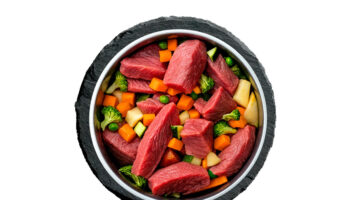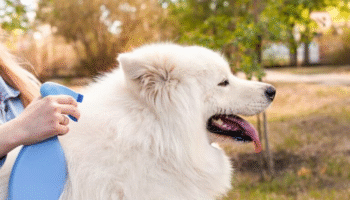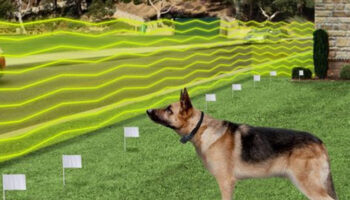Having dog breath is extremely common. After the age of three, they are present in roughly 80{f2f26ab5e03d0b265ae22b445d1101598e678ef39f67fc70960081a2b98018f9} of dogs. Dog’s breath, also known as periodontal disease, causes the gums and bone that support the teeth to deteriorate severely.
Your dog’s health is in danger because the infection that causes dog bad breath can spread through his bloodstream and affect his kidneys and liver.
Gingivitis, the initial stage of periodontal disease, can be treated effectively. If left untreated, however, it can progress into periodontal disease, which can be treated but not cured. And the worse it gets, the quicker it goes.
Periodontal disease can be avoided with routine professional cleanings and veterinary checkups beginning early in your dog’s life.
You can start a home oral hygiene routine, but it can be challenging to clean a dog’s teeth thoroughly if he or she would rather be doing something else.
Vets typically advise annual cleanings, but your dog’s condition may necessitate more visits. It’s best to start acclimating your dog to the idea of having his teeth brushed at an early age.
The following are some ways to keep your dog’s breath fresh:
– The teeth of your dog should be brushed at least twice a day. It’s important to remember to floss every day.
Initiate the programme when your dog is still a puppy. It’s best to get going as soon as possible.
– To begin, your dog must get used to your touching its head and jaws. If you lift her lips, you may examine her teeth and gums from all angles.
– Then, begin running your finger over the gums and teeth as if it were a toothbrush. Just give your dog a little time to adjust.
Because even though a newborn may not have teeth yet, there are already germs present, this is comparable to how you could introduce brushing to a baby, beginning with simply the gums. Use your finger to swab out your puppy’s mouth and rub its teeth.
– Wrap some gauze or a damp washcloth around your finger, and touch the outside and inner surfaces of your dog’s teeth and gums.
At last, a toothbrush is introduced. Get going with a manageable task. Once your dog is comfortable with the brush, you may ditch the gauze or washcloth. Do everything you can to fix the remainder of your dog’s mouth. Make sure the interior is brushed out as well.
If you start with the first step and work your way up to the toothbrush gradually, you may reduce your daily brushing time to only one or two minutes.
With regular dental care, your dog will learn that the process is painless, and it will happily offer you a few minutes of its time each day.
It may take your dog 8-16 weeks, but it will come to enjoy the regular brushing that you perform for it. Dogs thrive on human interaction. Your dog may even learn to sit still while you wash its teeth.
Fixing Canine Halitosis: A Guide for Pet Owners
It’s likely that plaque is to blame for your dog’s unpleasant breath. If you haven’t brushed your teeth in a while, a film of germs called plaque has formed over your teeth.
In addition, it may cause unpleasant and perhaps life-threatening gum infections. Your dog’s breath may be kept fresh and minty with just a little effort.
Imagine how bad your breath would be if you skipped brushing for a week. Yuck. While daily brushing is preferable for your dog’s oral health, brushing twice weekly is OK.
The prospect of cleaning your dog’s teeth may strike fear in your heart, but if you start while your pup is small, it will quickly become a pleasurable routine. If you try to brush right away, you should expect a loud protest. Begin by gently touching and massaging your dog’s mouth.
Engage in this for a short time every day and praise their efforts. After acclimating yourself to your dog’s mouth for a few days, you may begin to brush in circular movements by elevating the lip with a piece of gauze on your finger.
If you wait until they’ve gotten used to it, you might be able to move on to other teeth. A dog-specific soft bristle brush can be used instead after some time has passed.
Now you can even get dog toothpaste. Various flavors, including chicken, beef, and malt, are available. Because of this, they will have a much better time. Avoid using human toothpaste, as the foam will be too much for a dog to handle, and the dog will likely vomit if you try to brush its teeth with it.
If your dog still resists having their mouth touched after all the training, you can always get a toy. A grove-filled hard rubber toy is available.
Many veterinarians suggest this toy for canine patients who resist dental care. For the sake of your dog’s teeth, it has been custom-made. A small amount of dog toothpaste can be placed in the grooves, allowing your dog to clean his or her own teeth.
Some folks whip up a pot of oxtail stew once in a while. A cooked oxtail is an option for those who want to share it with their canine companion. The tendons in the tail can be used to massage the gums and teeth. For cleaning those out-of-the-way spots, this tool is invaluable.
Try a raw carrot instead of oxtail soup. A little piece of carrot may be given as a snack and also serve as a tooth scraper. The mildness of this solution will be belied by its efficacy in removing noxious plaque. You may get a mouth spray for your dog that works the same way it does for humans.
Don’t continue feeding your dog from a can. In order to lessen bad breath, try switching to dry foods. If you feed your dog dry food, it may damage the enamel. Don’t give your dog any table scraps to chew on all day either.
Your dog’s mouth is constantly producing dangerous microorganisms. In the event that your dog has not completed eating after half an hour, please remove the bowl from the table. Feeding your dog a few times a day is like feeding the germs a few times a day.





